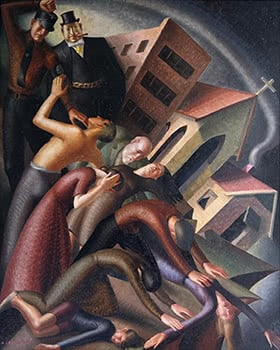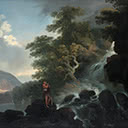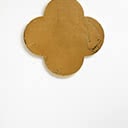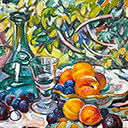Collapse
75 x 60 cm
est. $100,000 - 150,000
PROVENANCE
Purchased directly from the artist by current owner
Private Collection, Christchurch
LITERATURE
Lois White excelled at geometrical life drawing which was introduced by Englishman Archibald Fisher (1896- 1959) to the Elam School of Fine Arts in 1924. She developed a style characterised by the stylisation and repetition of figures, catching the rhythm of Art Deco and the Jazz Age which defined her youth. Teaching part-time at Elam herself by 1928, the year after she completed study, she became a full-time tutor in 1935, remaining on the staff until 1963, and completed an estimated 400 paintings and 1000 drawings during her career.
Challenged by Fisher to provide a commentary on contemporary life in her art, Lois White painted metaphorical treatments of the defining moments of her era: the advent of radio broadcasting, cinema, the Depression and World War II. Influences from the Australian commercial artist Charles Meere (1890- 1961) and the American Regionalists are evident. Collapse is reminiscent of Thomas Hart Benton's (1889-1975) wartime series of paintings The Year of Peril (1941-2) which depicted the Nazi threat to American ideals. Like Benton, an avowed Regionalist, White wanted to distinguish her work from surrealism, cubism, impressionism "or any other fancy pants medium", and described herself as a visualist. Despite this, her forms show a cautious modernist stippling of the surfaces describing forms. With fellow Elam artists who eschewed abstraction, she formed The New Group in 1948, declaring "We see more fully into the soul of the subject. It has been our aim to see not only with our eyes but with our minds."
Unlike Benton who championed America's entry into the Second World War after Pearl Harbour, White was a pacifist whose beliefs were rooted in her lifelong Methodism. Her religious subjects such as the Annunciation, Conversion of Saul, Deluge, Foolish Virgins, Eve Tempted as well as the epic resurrected Christ in Religion and Life (1935), link her work to the British paintings of Biblical narratives by Stanley Spencer (1891-1959). Her 1951 painting of Jonah and the Great Fish was selected for display in the Women's International Art Exhibition at the 1951 Festival of Britain, and her 1935 mural of Christ riding into Jerusalem on the back of a donkey on Palm Sunday was purchased by Te Papa in 1990. The Auckland Art Gallery's 1994 exhibition of her work, curated by the late Nicola Green, toured to six venues was titled By The Waters of Babylon (after her 1954 painting based on Psalm 137 of the Songs of David), and it resurrected her reputation posthumously.
The importance of Christianity to her conception of a civilised life is evident in this composition, where a church and a traditional house are being forced out by a looming Brutalist housing block. The dark forces of design are joined by a caricature of a banker and a Storm Trooper raising his fist to strike a young man who is stripped to the waist in front of him. Despite being aware of the Nazi persecution of Jews in Germany at the time, White chooses to show the capitalist colluding with the Nazi with Jewish features. When a friend and patron objected to the anti-Semitism, she changed the six-pointed Star of David at the figure's throat to a five-pointed sheriff's badge. The same top- hatted figure had already appeared in her painting War Makers (1937, in the collection of the Auckland Art Gallery), where she claimed "the main idea behind the composition is the injustice done to youth by the decision of the older generation to have wars and send their sons to be slaughtered and maimed, while many grow fat on the proceeds".
The political content of Collapse went unremarked by reviewers when it went on display in the Auckland Society of Arts Exhibition in June 1944. Arthur Hipwell commended her synchromism, commenting on the rhythmic design and rich colour. She has ensured that the figures being oppressed are of different ages, wearing clothing in harmonising tones of red, green, blue and brown. Auckland Art Gallery's preparatory drawing shows how she carefully worked out the diminution and placement of each body so that they appear to fall down like dominoes in a cascade. Civilisation is clearly collapsing, and the immediacy with which Lois White paints this allegory challenges the viewer to intervene.
LINDA TYLER
ILLUSTRATED
By the Waters of Babylon: the Art of A. Lois White, Nicola Green, Auckland City Art Gallery, 1993
The Mindless Enemy, Dianne Bardsley & Mike Burr, New House Publisher, 1995
p. 81 The Invention of New Zealand Art & National Identity 1930 - 1970, Francis Pound, Auckland University Press, 2009
Listener review, 20 March 2010





